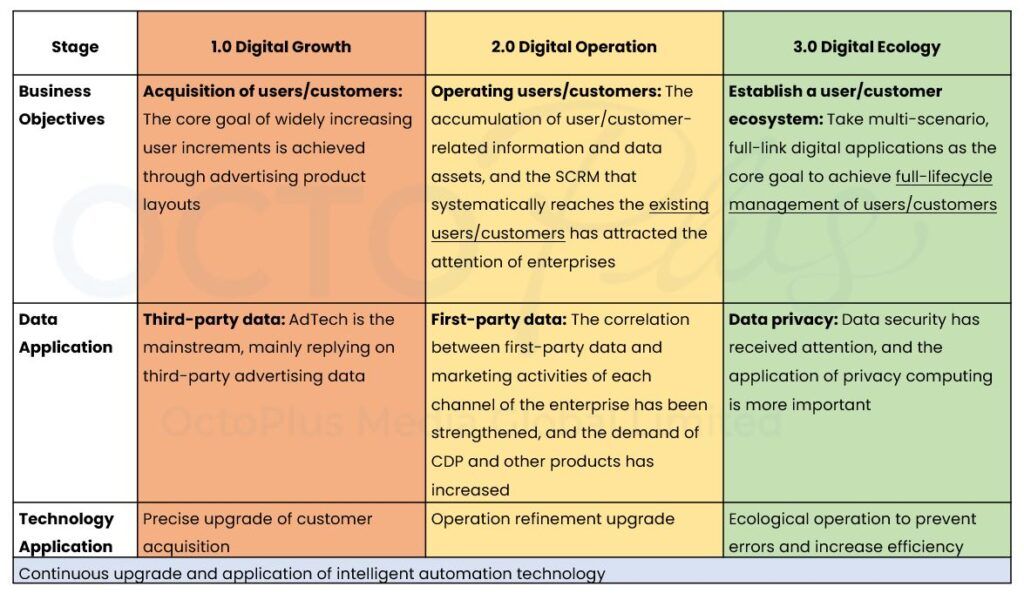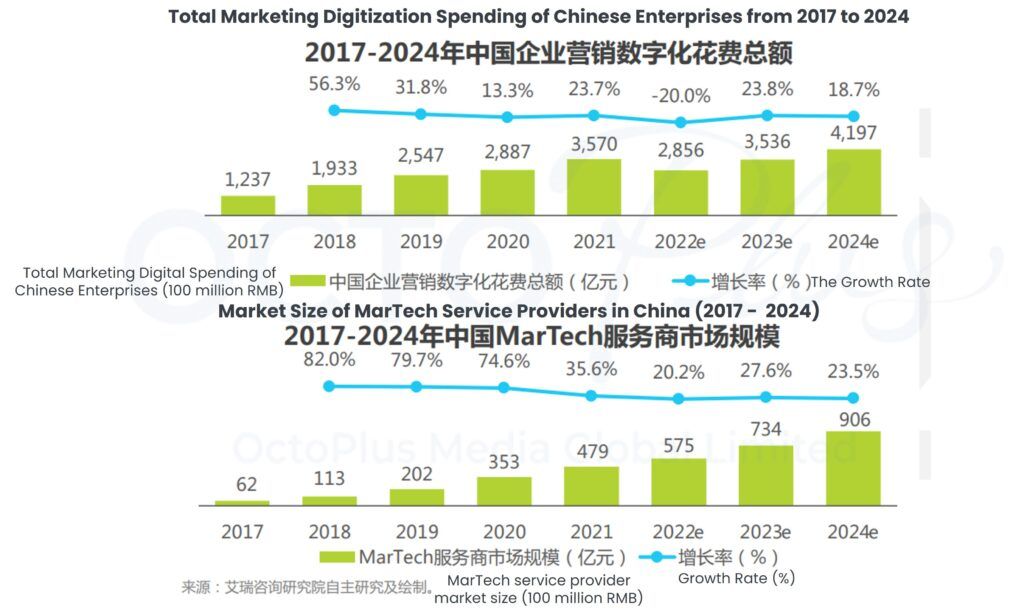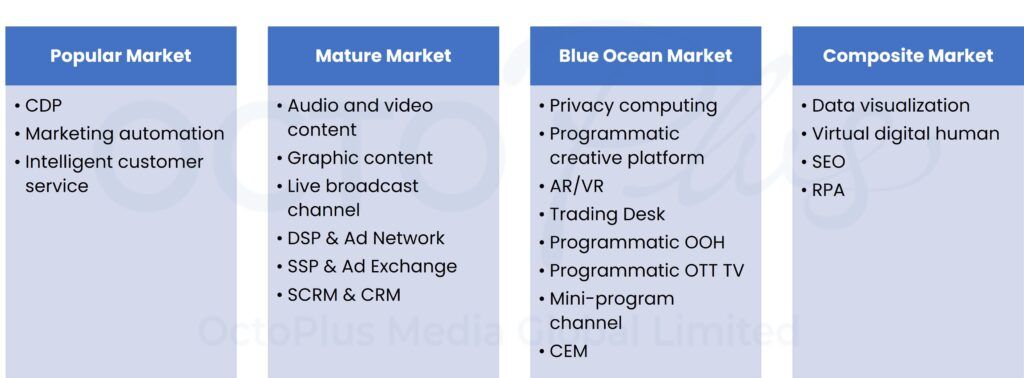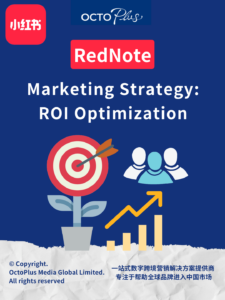2022 China Enterprise Marketing Transformation Roadmap
Marketing digitalization is an indispensable part of an enterprise’s digital strategy and an important part of the development of the digital economy. According to the China Academy of Information and Communications Technology (CAICT), the scale of China’s digital economy in 2021 has reached 45.5 trillion, accounting for 81.7% of the digital scale contribution, indicating that the digital economy is in a period of rapid development. iResearch published the “China MarTech Market Research Report”, the following is an overview of the key points compiled in the report.
Chinese enterprises’ thinking about marketing digitalization can be divided into three phases: digital growth, digital operation and digital ecology. The following table shows the analysis of the development context of each stage.

In 2022, iResearch remains optimistic about the long-term investment in marketing digitalization due to the impact of the epidemic and the economic environment, the overall budget reduction of enterprises, and the simultaneous temporary decline in consumption related to marketing digitalization. As the market of MarTech service providers continues to mature, the budget of enterprises in marketing digitalization will increase the service and product procurement of more and more MarTech service providers.

According to the current distribution of service providers in China’s digital marketing segmentation scenarios and development periods, the number of service providers in more segment scenarios is still relatively small, such as the blue ocean market and the composite market, which are expected to gain more market attention under the impetus of the development of the Metaverse. The mature market is a development opportunity with the continuous strengthening of AI technology, which can be regarded as a blue ocean market with great development potential. Finally, there is the popular market, in a relatively short period of development, a large number of service providers have emerged, which include the sophisticated and intelligent operation of users or customers has become the core focus and demand hotspot for enterprises in the existing market. The following is the current status of the number of service providers in China’s marketing digitalization scenarios in 2022.

Advertising scenarios and status of marketing digitalization in channel operation
In 2021, the market share of advertising placement on e-commerce platforms and short video platforms was 40.3% and 22.9% respectively, representing the largest share of the online advertising market of many media types, It is expected that there will be a greater demand in the advertising business in the next three years, driving the application of digital resources and more innovative tools.

The analysis of the digital development status of the main channel types includes the following:
Online shopping channel: The level of commercialization and digitalization is high, and in the future, there will be more efficiency improvements around each operational link, reducing operating costs for brands and retailers
Live broadcast channel: Emerging marketing channels, users and transaction volumes are growing rapidly. Going forward, more attention will be paid to developing back-end links in live broadcasts, to create more features and value at the continuous operations level based on redirects
Mini program channel: Emerging + private traffic marketing channels that enable established brands and merchants to have the same comprehensive experience as public e-commerce, will be at the heart of the development to build the integrity of the mini program marketing ecology in the future
Offline store channel: The most popular marketing channel is limited to data collection and analysis. Therefore, the future digital direction will focus on collecting and linking complete offline consumption data to achieve the same level of digitalization and operation mode as online channels
Offline channel for events/conferences: As a commonly used supplementary channel, it is used for dissemination and announcement at specific times or objectives, and the value of conversion and digital value is very low, the future development direction is based more on event management efficiency
Pain points of marketing digitalization in Chinese enterprises
General pain points: People and organizations are the common points of marketing digitalization in enterprises. The urgency and necessity of marketing digitalization are perceived differently at different levels of the organization, and the subjective readiness and acceptance of employees also vary, making it difficult to achieve a unified understanding. In addition, corporate culture and long-standing work habits have an impact on the implementation of the marketing digitalization process in the organization and to some extent impair collaboration and sharing between organizations, such as the lack of willingness to expand marketing digitalization or the insufficient skills
Phase pain points: Although enterprises have begun to realize the importance of marketing digitalization with the help of the general environment (the rapid development of communication facilities and mobile internet), enterprises that have not yet entered the MarTech market, are faced with unclear directions, do not know whether to enter the game and do not know the direct demand, which also creates phase pain points in the decision-making and design phase.
End-of-Scenario pain points: In 2022, Chinese enterprises will face different pain points in different scenarios of marketing digitalization: In data and strategic marketing scenarios, enterprises focus on data security and quality; in content and creative marketing scenarios, content quality and optimization are crucial to enterprises; in advertising marketing scenarios, enterprises face the difficulty of navigating between and integrating scenarios; in channel operation and conversion scenarios, it is difficult to convert resources between channels, product functions and integration are difficult to support; finally, integrated service capability in customer and process management is weak, and the limited level of intelligence may have a negative impact on marketing strategy formulation and enterprise user.
Trend 1: Integrated services
It is difficult for a MarTech service provider to combine the complete marketing linkage of multi-scenario products that support a business. The cooperation and collaboration of small ecological service providers will empower the overall marketing digitalization of enterprises
Trend 2: Market consolidation
With the continuous development of China’s MarTech industry, it is becoming increasingly difficult to penetrate platform data, and data silos are becoming more and more obvious. The MarTech industry will face reshuffling, ushering in integration and consolidation, and data-based service providers will be preferred.
Trend 3: Deepening operations
The development of MarTech enterprises will focus on customer operation, exchange channel transformation and technological form upgrade
To learn more about digital marketing or interested in advertising, please contact us for more details.
Feel free to talk to us
It’s a team with one single shared goal, which is our client’s success. Deliver results for your business now.
































